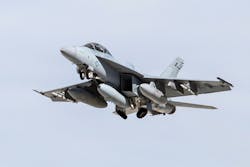Boeing and Lockheed Martin to build advanced infrared search and track (IRST) for Navy Super Hornet
PATUXENT RIVER NAS, Md. — U.S. Navy air combat experts are asking electro-optics engineers at the Boeing Co. and Lockheed Martin Corp. to design and build improved infrared search and track (IRST) sensors for the F/A-18E/F Super Hornet jet fighter-bomber to enable the aircraft to detect, track, and attack enemy aircraft in a stealthy way without making its presence known.
Officials of the Naval Air Systems Command at Patuxent River Naval Air Station, Md., announced a $152.5 million contract Friday to the Boeing Co. Defense, Space & Security segment in St. Louis to design and build the IRST Block II, Phase II engineering change as a replacement to the IRST Block I system on F/A-18E/F carrier-based combat jets.
A new IRST will enable the Navy F/A-18E/F Super Hornet to search for targets in a stealthy way.
The Super Hornet’s IRST is a long-wave infrared detection system that targets airborne vehicles in a radar-denied environment. The system, which Boeing is buying from the Lockheed Martin Missiles and Fire Control segment in Orlando, Fla., uses infrared search and track technology to detect and provide weapon-quality track solutions on potentially hostile aircraft.
The IRST Block I, also called the IRST21 Sensor System, fits on the front of the Super Hornet’s centerline fuel tank. Two years ago Navy leaders approved a restructured program that foregoes full-rate production of Block I sensors and proceeds directly to the Block II system.
The IRST consists of a passive longwave infrared receiver, a processor, inertial measurement unit, and environmental control unit. The infrared receiver, processor, and inertial measurement unit are fitted inside the sensor, which attaches to the front of the fuel tank mounted to the aircraft on the BRU-32 bomb rack.
The Navy developed the IRST Block I using components from the F-15K/SG aircraft’s infrared receiver, which is based on the IRST design of the now-retired Navy F-14 Tomcat jet fighter. IRST Block II will include improvements to the infrared receiver and updated processors.
At this stage, existing IRST Block I systems will support testing and tactics development. Navy leaders say they will begin the Block II operational tests in 2020. The Navy intends to produce 170 IRST systems.
Even amid electronic attack or heavy RF and infrared countermeasures, IRST provides autonomous, tracking data that increases pilot reaction time, and enhances survivability by enabling first-look, first-shoot capability, Lockheed Martin officials say.
Infrared sensors like the IRST detect the heat from an aircraft’s engine exhaust or even the heat generated by the friction of an aircraft as it passes through the atmosphere. Unlike radar, infrared sensors do not emit electronic signals, and do not give away their presence to adversaries.
This ability can enable Super Hornet pilots to make positive identification of enemy aircraft at long ranges, and enable them to fire their air-to-air missiles at their maximum ranges.
Data from the IRST system can stand alone or fuse with other on-board sensor data situational awareness. Lockheed Martin also is developing an IRST pod that can be fitted to the F-15C and F-16 jet fighters.
On this contract Boeing and Lockheed Martin will do the work in Orlando, Fla., and in St. Louis, and should be finished by December 2021.
For more information contact Boeing Defense, Space & Security online at www.boeing.com/company/about-bds, www.lockheedmartin.com, or Naval Air Systems Command at www.navair.navy.mil.

John Keller | Editor
John Keller is editor-in-chief of Military & Aerospace Electronics magazine, which provides extensive coverage and analysis of enabling electronic and optoelectronic technologies in military, space, and commercial aviation applications. A member of the Military & Aerospace Electronics staff since the magazine's founding in 1989, Mr. Keller took over as chief editor in 1995.

